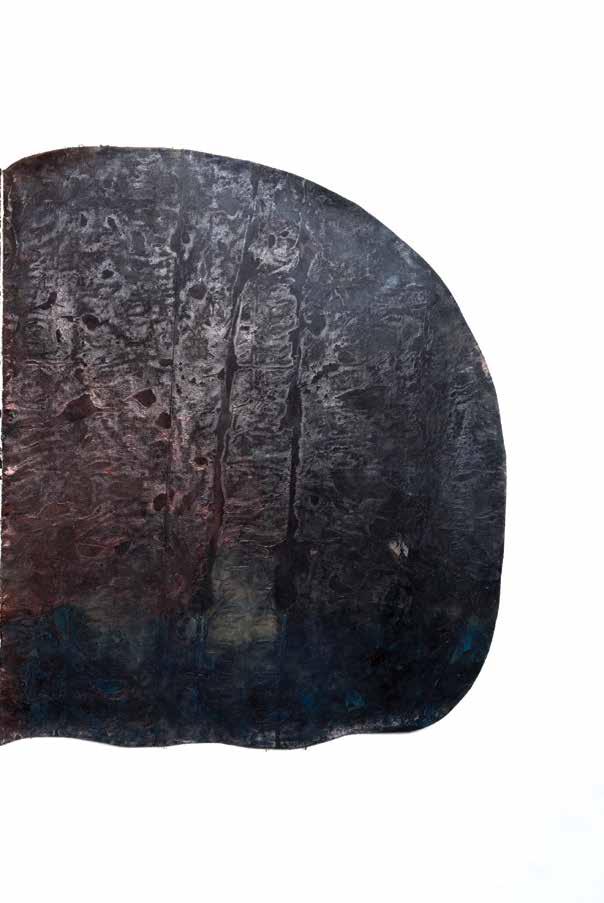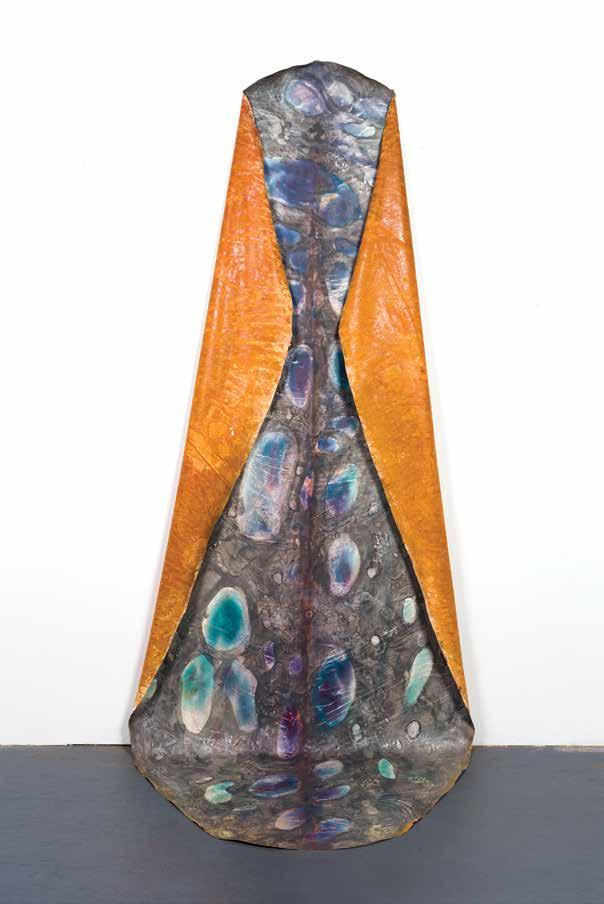

The Shape of Being
CAMERON HARVEY


Over the past few years, artist Cameron Harvey has developed a distinct idiom that involves painting two unstretched canvases side-by-side on the floor and then hanging them on the wall to form a single large-scale work. Sometimes Harvey arranges the canvases so they touch in the middle or drape onto the floor, or she pins them so their edges curl forward, revealing the back of the painting.
On the occasion of her first solo museum exhibition, Harvey details how she arrived at her current approach to painting and what it evokes for her, with sources and reference points as wide ranging as the forms of rocks and leaves discovered on nature walks, the ancient Chinese philosopher Lao Tzu, yoga, recent assemblages by Richard Tuttle, and the physics of time and gravity.
The text below is excerpted from conversations with Weisman Museum director Andrea Gyorody, and has been edited for length and clarity.
I began graduate school at ArtCenter College of Design in Pasadena in 2019, and I continue to develop the body of work that came out of my time there. Prior to art school, when I was living in Chicago, I was making large layered airbrush paintings on the floor. Working on the floor is something I have been doing for the past 10 to 15 years. After school, I realized that my mode of working on the floor, with layers of color, comes directly out of my background in printmaking, which made me feel comfortable working on a horizontal plane, and prepared me to find joy in the surprise of pulling up the canvas to reveal the results of my moves, similar to the way a printmaker pulls up paper from a plate . . .
There is something natural to me about working on the floor; it is where I feel at ease. It is probably linked to my yoga practice. I have been practicing and teaching yoga for almost 25 years. Through my practice I have built a habit of finding discipline, joy, and release by being on the floor. The floor is my happy place and for me, being barefoot on the floor feels like home. On the ground I can make things as big as I want, in any shape that I want, and not worry about supports, table size, moving furniture, etc. I can use my whole body and move works around without them feeling precious. I also find my work is best when I don’t overthink it, and I am not too fussy with my mark-making. As a result, I set up parameters for my own practice so that I can get out of my own way and let the work become the work. I achieve this when I work on the floor, wet on wet, and the piece

I am working on is so big that I can’t quite see what I’m doing because I’m in it, and it’s too big for me to get fussy about. When it dries, and I pull the piece up and hang it on the wall, we see each other face-to-face, and that is when I can continue to make choices. When I figured out how to get out of my own way, it felt very liberating.
In the spring of 2020, when I was in graduate school over Zoom during COVID, and the Black Lives Matter protests gained more visibility because of the murder of George Floyd, I was thinking a lot about the figure and the formal qualities of the human body that we judge on first sight, like race and gender. I was also walking a lot and observing the wondrous diversity of the flora in Los Angeles.
I noticed how the firestick plants were becoming more pink and orange and bright at their tips as spring turned to summer. I learned that the change in color was a sort of plant sunscreen to protect the plant as the days grew longer and the sun stronger. I was thinking about the formal qualities of shape and color and the formal relationship between figures and plants, as well as climate, struggle, the human condition, and how we protect ourselves.
That fall I started a body of work inspired by Frank Stella’s Black Paintings from the late 1950s. I was painting stripes on acrylic paint pours that I made in my landlady’s garden, using the stripes to give the puddles of color structure. What I took away from Stella’s process was to let the shape of the canvas be determined by the canvas’s center and radiate outward. This was a significant development, not only because of the formal consequences for my work, but because the idea of “the center” has deep and complex meaning in yogic and vedic philosophy, and to me personally. For 10 years I’ve posted on my studio wall a translation of verse 11 from the Tao Te Ching by Lao Tzu, describing how emptiness in the center is what makes a pot or a room useful.
Around this time, I was reading the zine that artist Amy Sillman made for the exhibition The Shape of Shape, which she curated for the Museum of Modern Art in New York. She writes, “If you think of shape as figure/ground, then every shape is a figure and the ground is the whole world.” That idea clicked for me, and I started thinking of each painting I was making as a figure, and the gallery or exhibition space as the ground.
Soon after, in the spring of 2021, I went to see Richard Tuttle’s show Nine Stepping Stones at David Kordansky Gallery. The show consisted of spray-painted plywood assemblages that he called “heads.” The works were all made of the same materials and repeated shapes, but in different configurations. When I left the gallery, I picked up a beautiful pink leaf outside the gate, and that’s when it clicked. I thought, “Oh, I can use the structure of the midline as a unifying formal element, like the midline

of this leaf, and within that, my work can be about wild diversity.” The concept and materials can be simple; diversity can play against structure.
I think of my works as figures, and because the body isn’t a rigid square, it doesn’t make sense to me to make square paintings. As the works are figures, it is important that they have a back and front and something that they are protecting or hiding, an underbelly of sorts. That is why I show the works up against the wall. I like the idea that a portion of the work folds forward so you can see the backside, and sometimes the back becomes the front, but there is always part of the piece up against the wall and hidden. It is also important that the softness of the unstretched work needs the rigidity of the wall to be held up, much like how the skin needs the skeletal structure, or bones need muscles and vice versa. The paintings can’t really exist without something like a wall giving them form. That interplay between rigidity and softness, and strength and surrender, is another reason why it’s important for me that my paintings are on the wall.
The folding and draping of the artworks brings the pieces to life and is related to working in collaboration with gravity. Gravity is key for me.
I have a rule that I can only pick up my source material from the ground, so if it was once alive, it is already in the process of dying because it fell. The color fade on a leaf is a direct result of entropy and change and the fact that it has been separated from its source. The midline can be thought of as the energetic pathway. In humans, our midline is our spinal column through which nutrients and nerve signals pass; in leaves it is the midrib. The midline is the empty space.
The way the works are presented— hanging with gravity—could be a state of becoming, unfolding, or collapsing and falling apart.
I don’t want to say they are in the process of “dying,” but they do allude to changing form, or changing into something else, which is what dying is. Impermanence is the experience of being alive; change is always happening. Gravity is what creates time, which is also a measure of change and aging and the cycle of life. This idea of working with gravity, not only in the making of the work on the floor, but in how the work hangs, is something I am always thinking about.
I made new work for the show at the Weisman Museum in response to walking in the area near the Pepperdine campus. I was struck by the geology and rock inclusions in the area and after a residency in Wyoming in March 2024, rocks were already coming into my work. Rocks added new ways of thinking about shape, color, and surface texture. Some rocks I found were fossils; they had once been shells or had imprints of leaves; they were two-sided organisms with midlines that had been petrified. This new development corresponded well with my interest in ceramics and my desire to include some of my earlier experiments with ceramics in the exhibition alongside my paintings. Clay is the earth itself, its color specific to place and geology, vitrified through firing into stone.

These are some of the ideas that have come together to make my work what it is. However, they are not necessarily what the work is about. At its core, I believe my work to be about the relationship between effort and surrender, doing and not doing, and the diversity that exists within sameness. I am after a sense of awe, belonging, acceptance, and letting go.
— Cameron Harvey

August 24–December 8, 2024
ABOUT THE ARTIST
Cameron Harvey (b. 1977, So. Pomfret, Vermont) lives and works in Los Angeles. Harvey received her MFA from the ArtCenter College of Design in Pasadena, California, in 2021; her BA in studio art from Wellesley College in 1999; and her postbaccalaureate certificate in painting from the School of the Art Institute of Chicago in 2007. Harvey’s work has been included in solo and group exhibitions both nationally and internationally. She held a teaching assistantship in printmaking and painting at La Scuola Internazionale di Grafica in Venice, Italy, in 2001, and most recently was an educator at the Museum of Contemporary Art in Los Angeles and a volunteer yoga instructor with Prison Yoga + Meditation. Harvey has participated in artist residencies at the Vermont Studio Center, the Lijiang Studio, the Chicago Artists Coalition, and the Ucross Foundation.
Cameron Harvey: The Shape of Being is curated by Weisman Museum of Art director Andrea Gyorody, in close collaboration with the artist.
Front: Ancestor 32, 2024, acrylic on canvas, 120 x 86 in.
Centerfold: Ancestor 31, 2024, acrylic on canvas, 69 x 118 ½ in. Interior, left to right: Ancestor 25: Ceratonia Siliqua IV, 2023, acrylic and graphite on canvas, 100 x 80 in.; Ancestor 36, 2024, acrylic and flock on canvas, 122 x 104 in.; Ancestor 38, 2024, acrylic on canvas, 115 x 91 in.; Ancestor 37 , 2024, acrylic on canvas, 115 x 58 x 34 in.
All works by Cameron Harvey. Images courtesy of the artist. Photos: David Daigle. © 2024 Cameron Harvey
FREDERICK R. WEISMAN MUSEUM OF ART
Pepperdine University 24255 Pacific Coast Highway Malibu, California 90263-4594
@weismanmuseumofart
